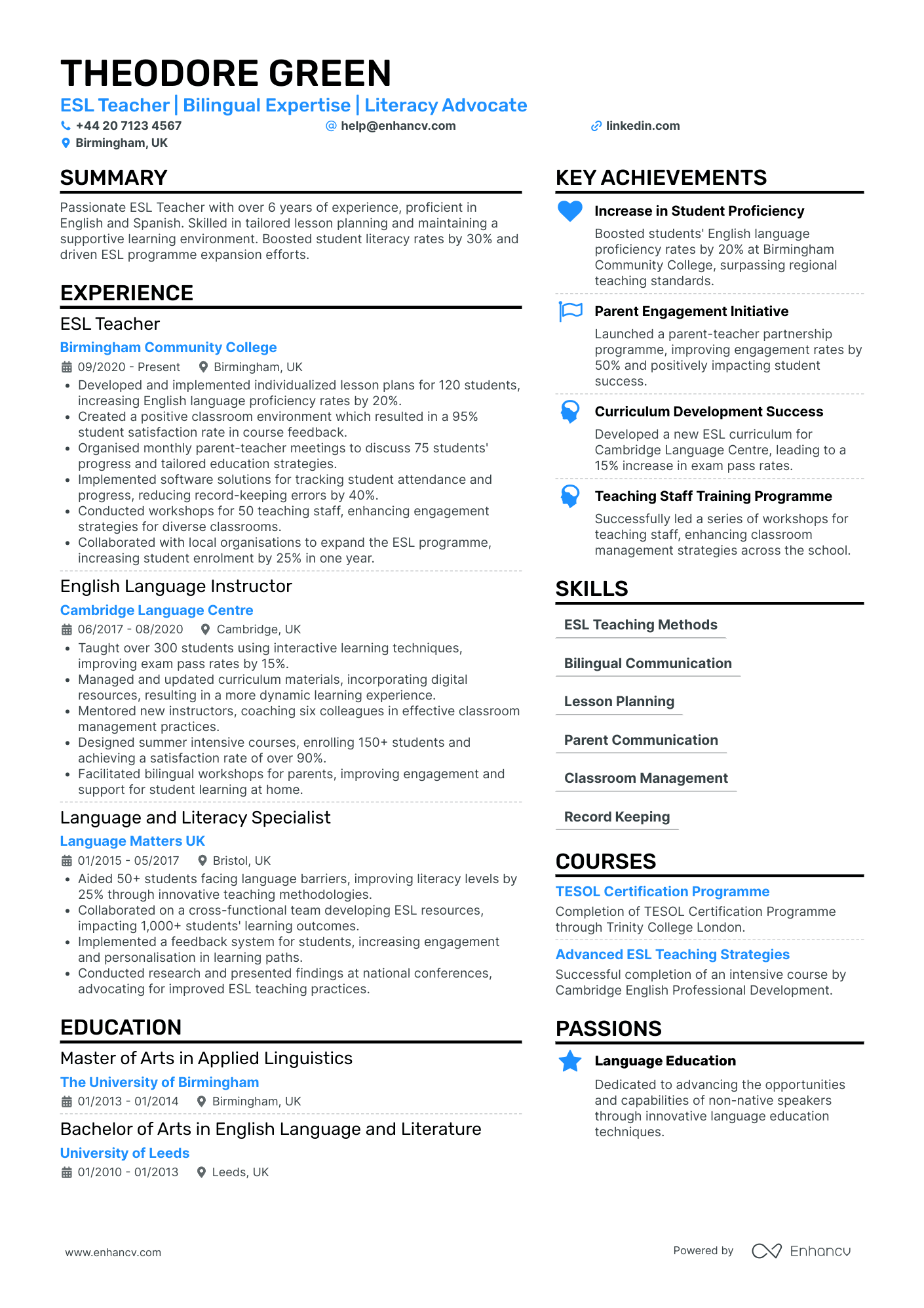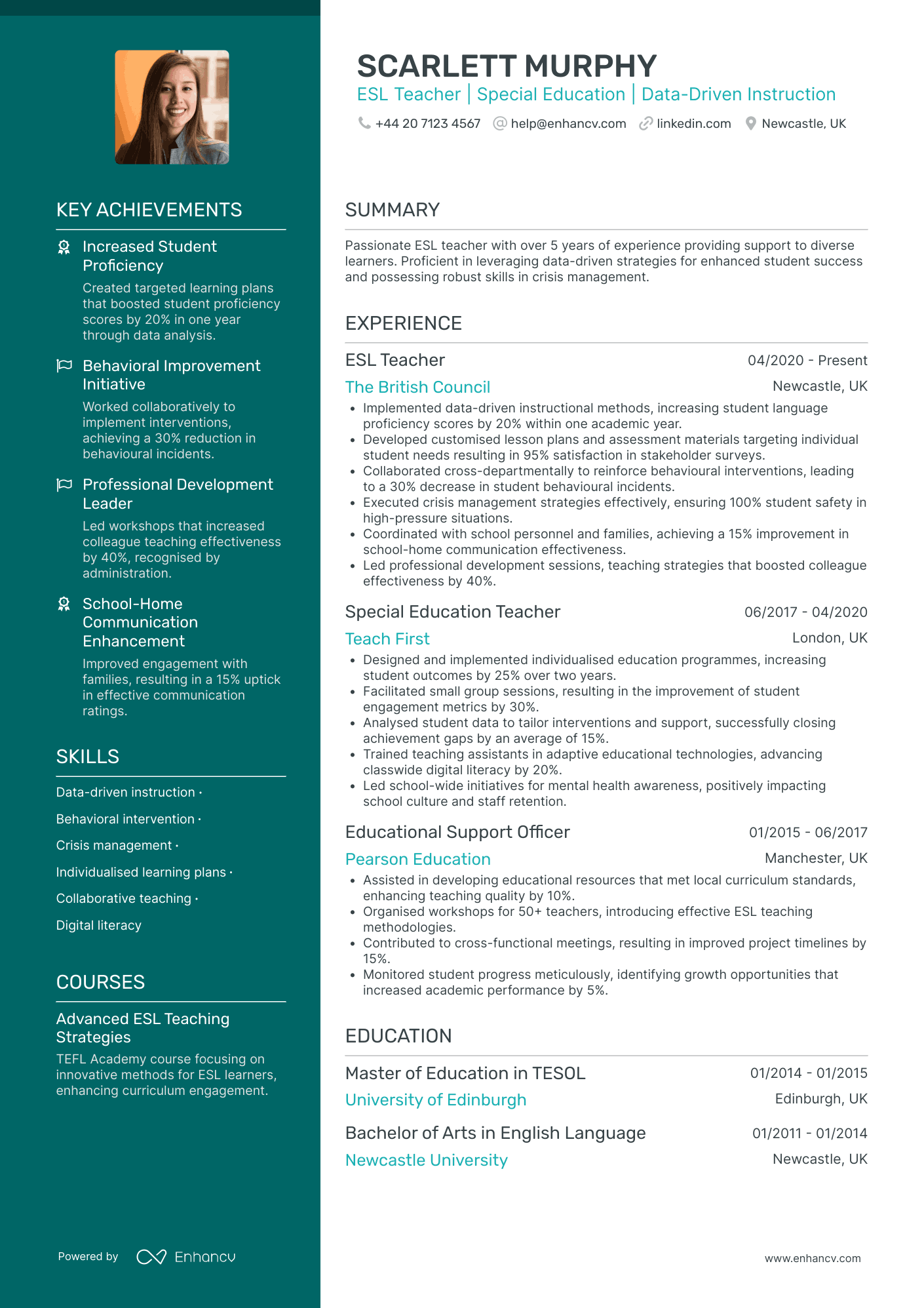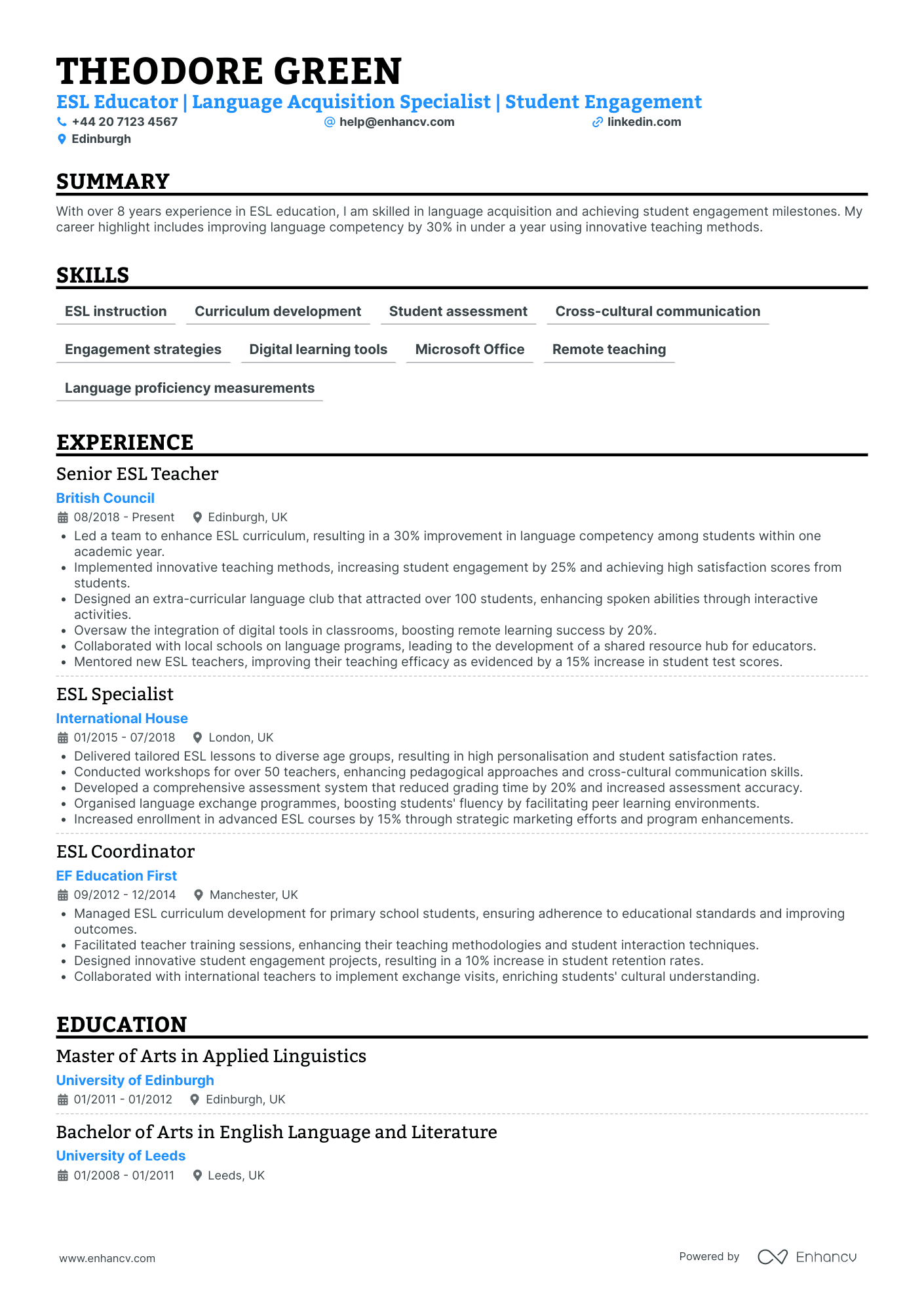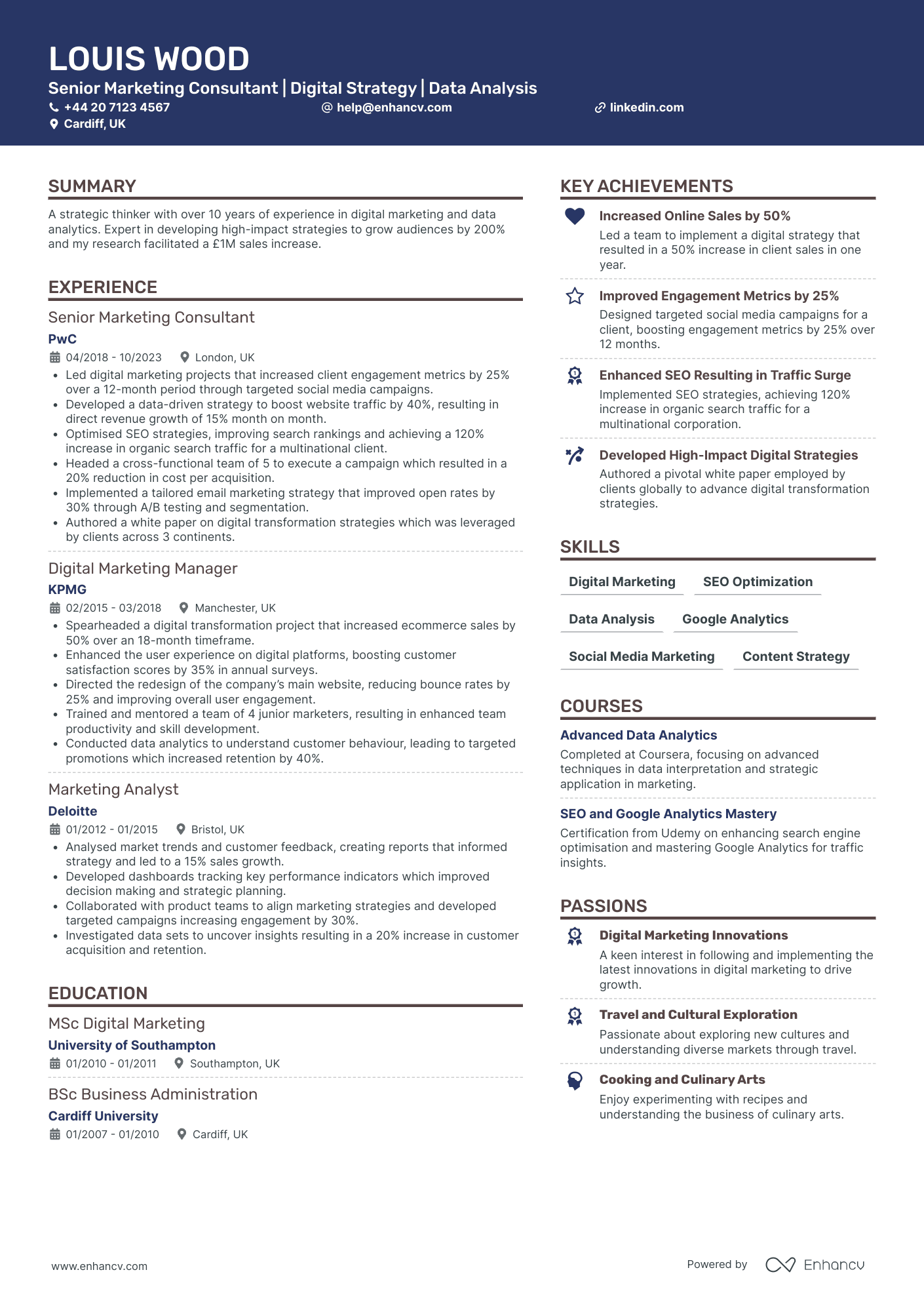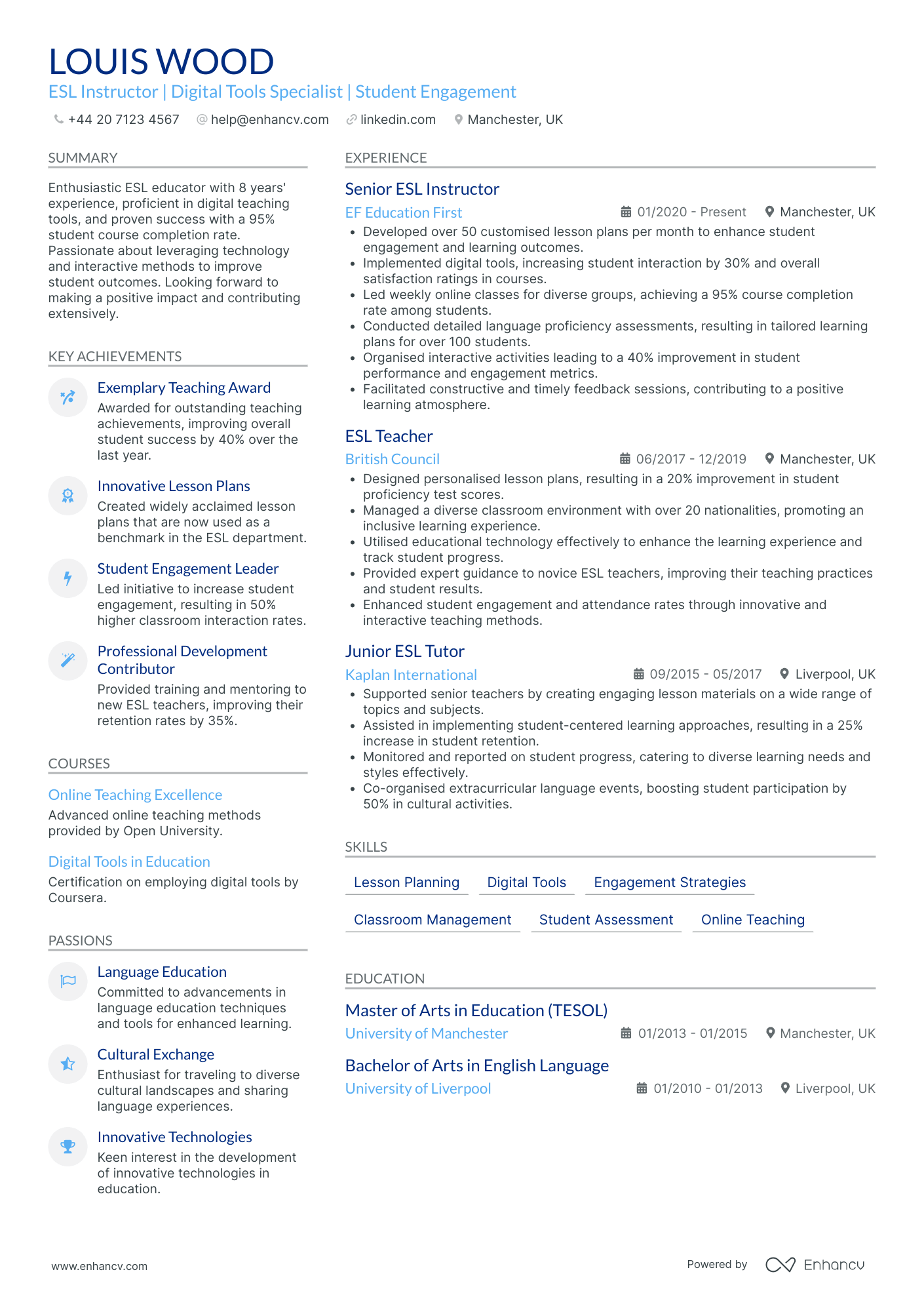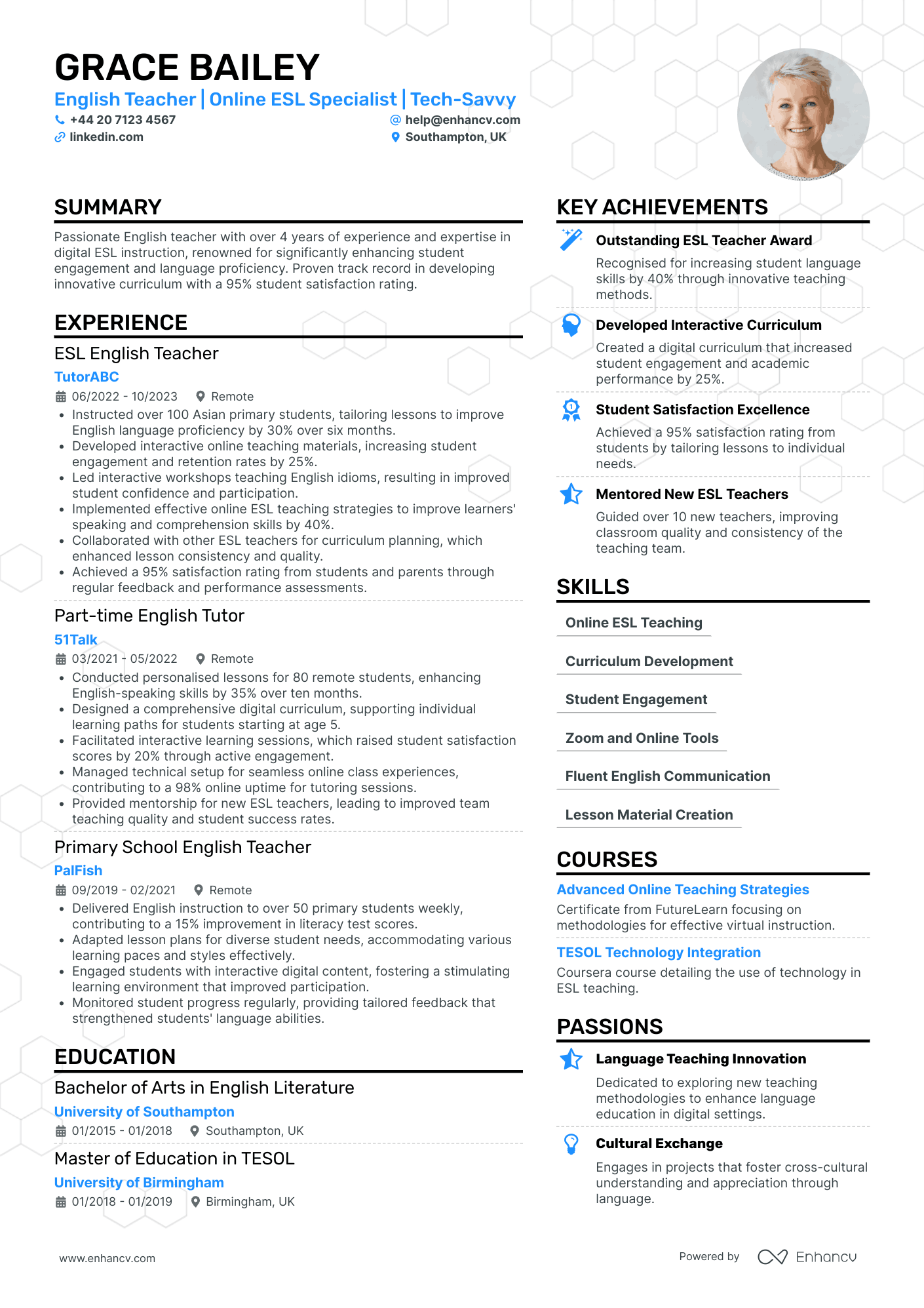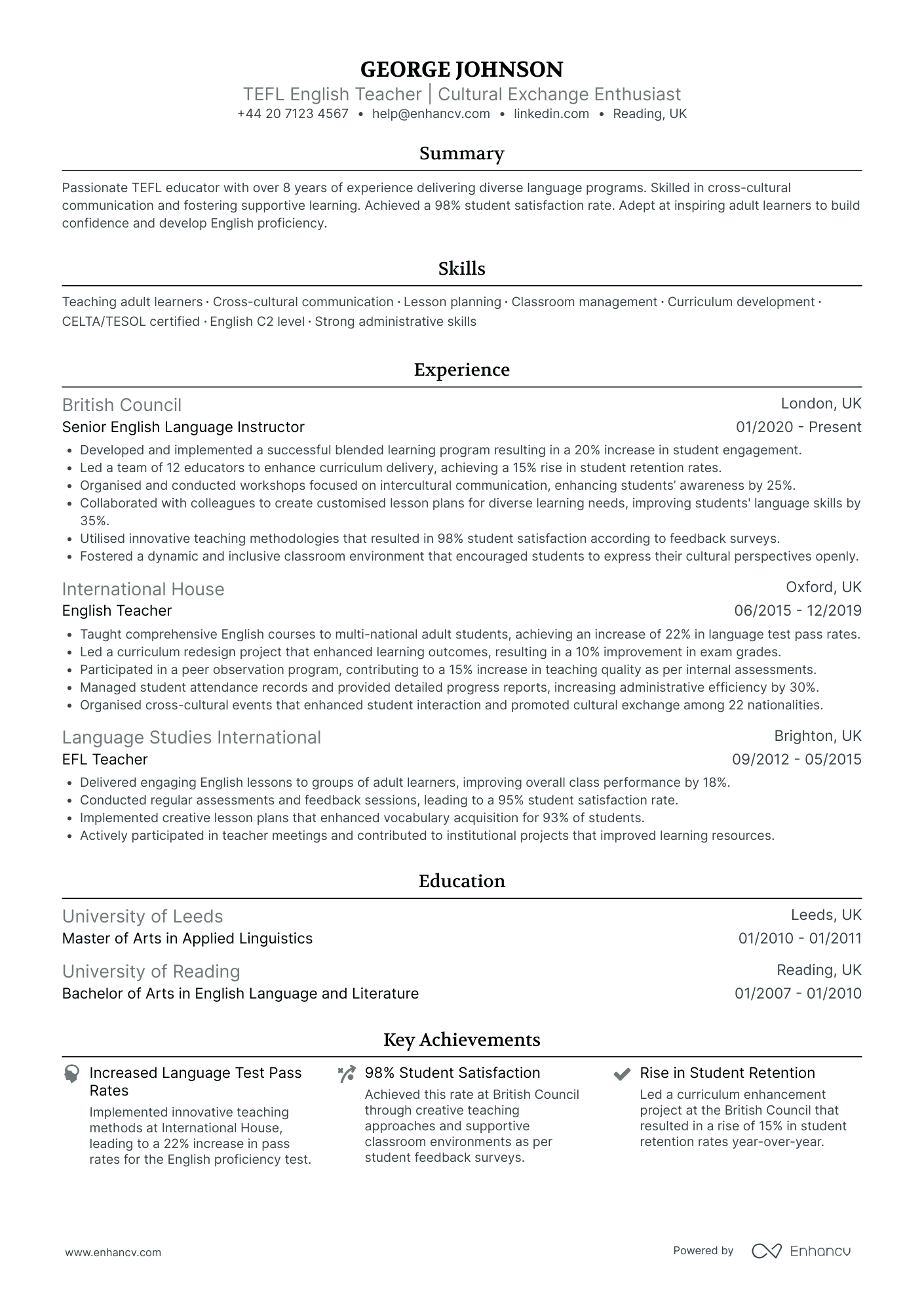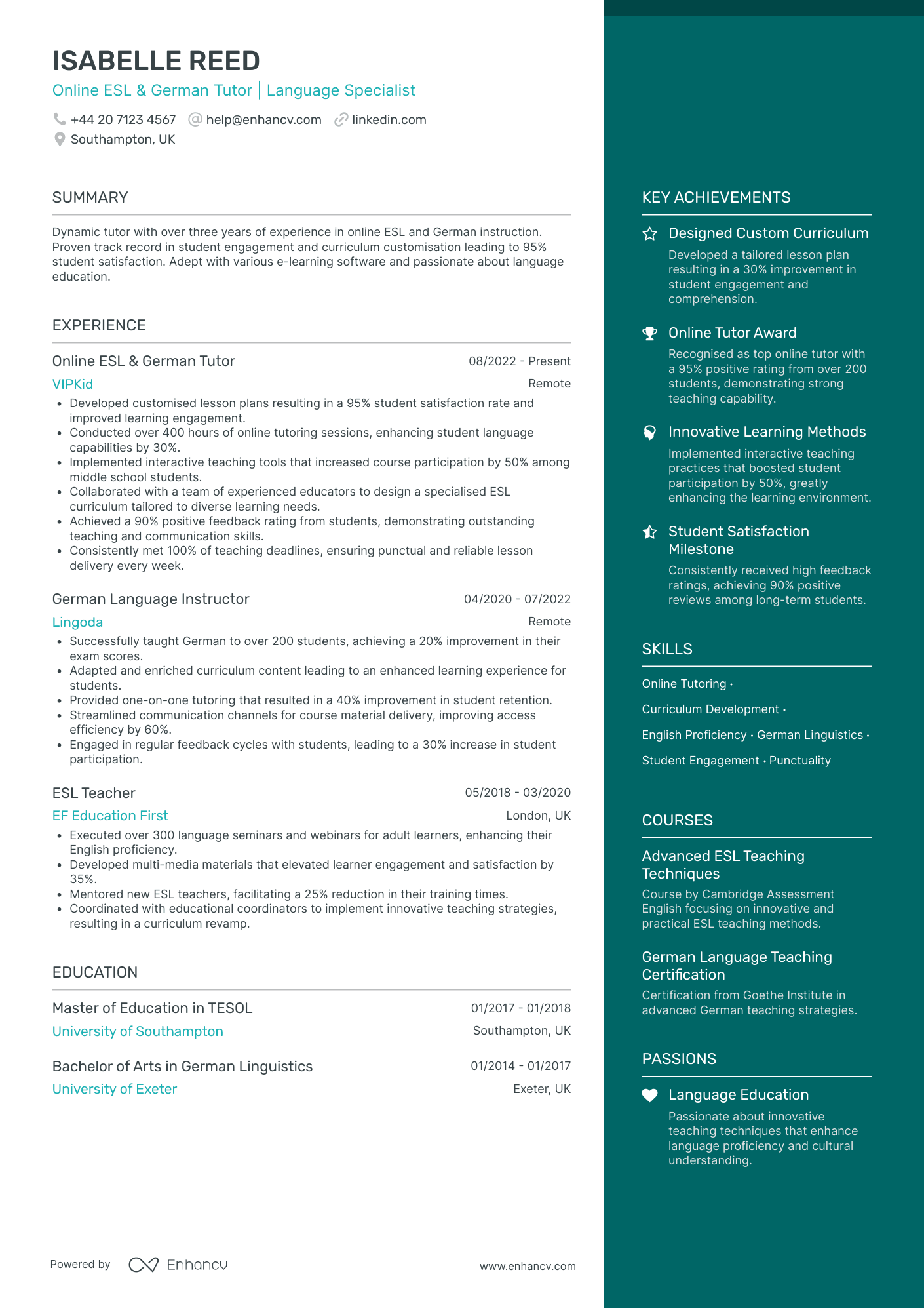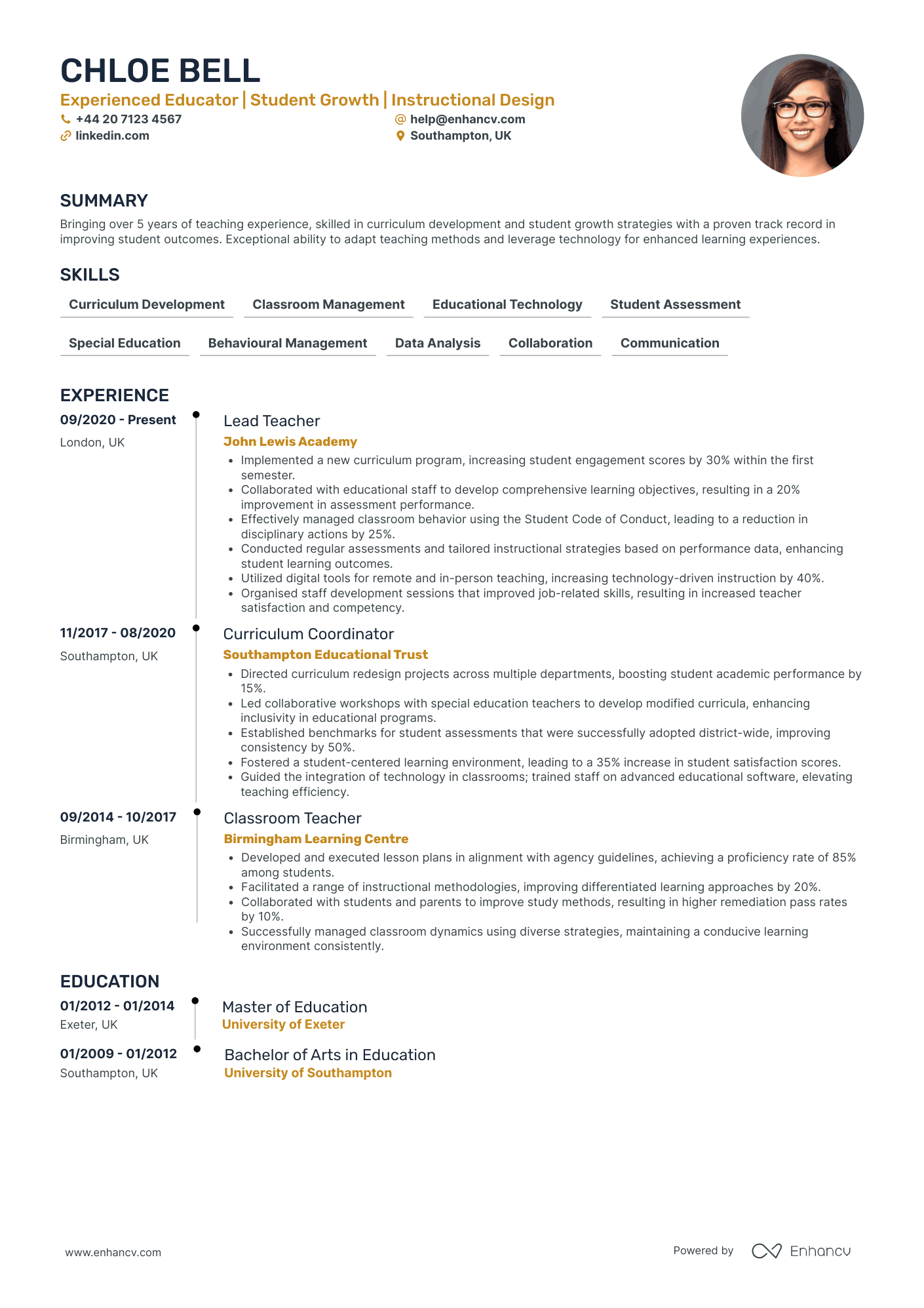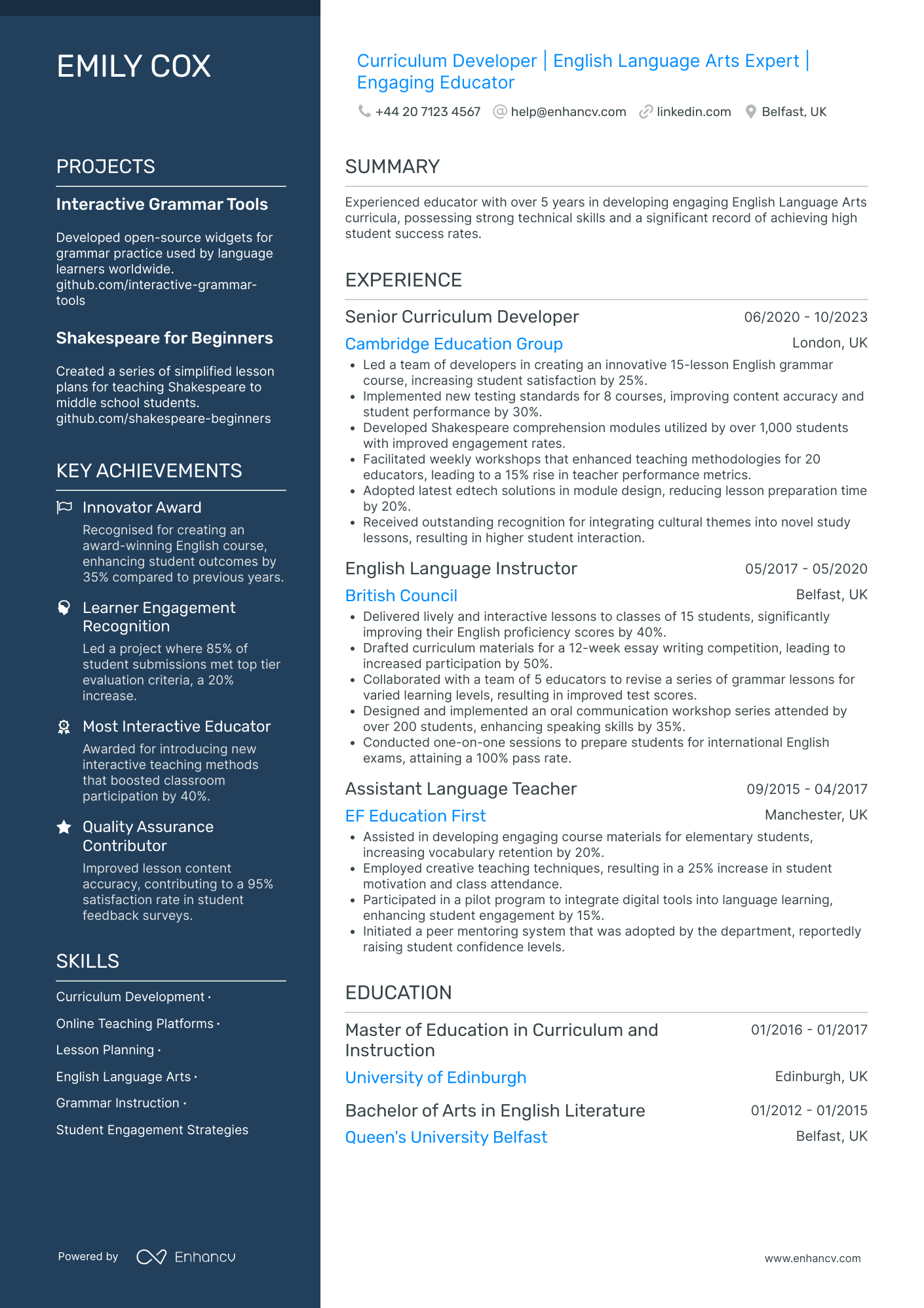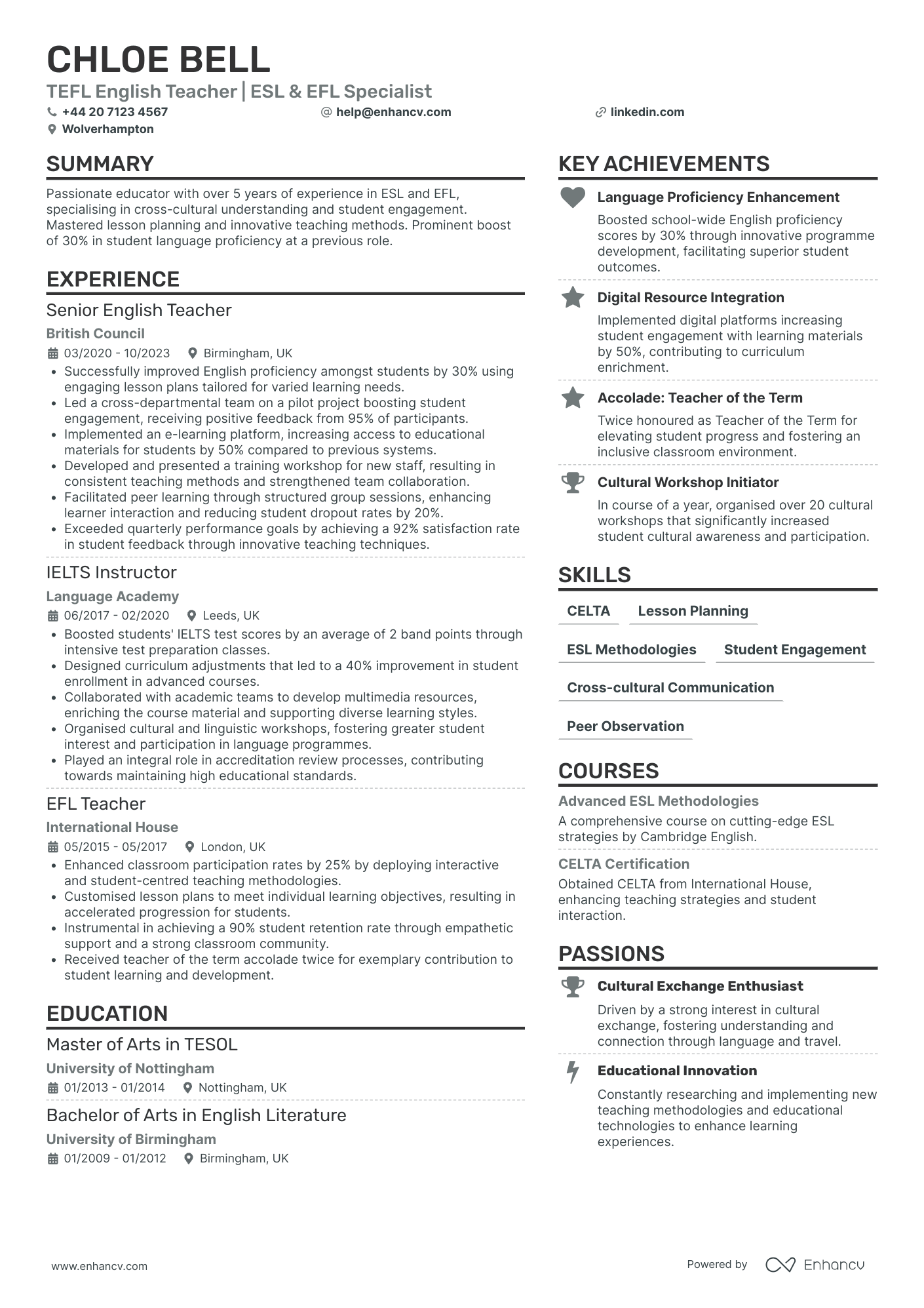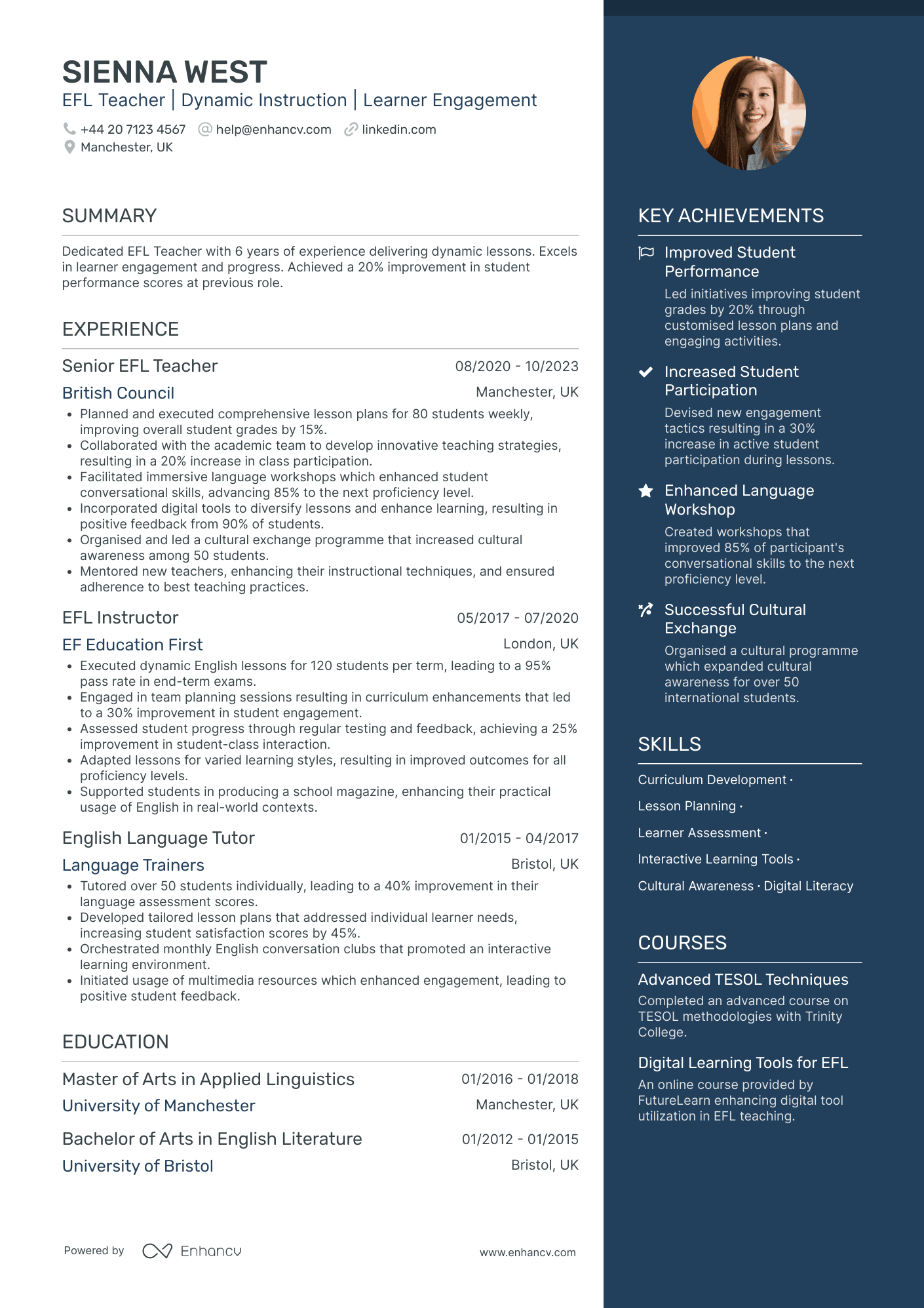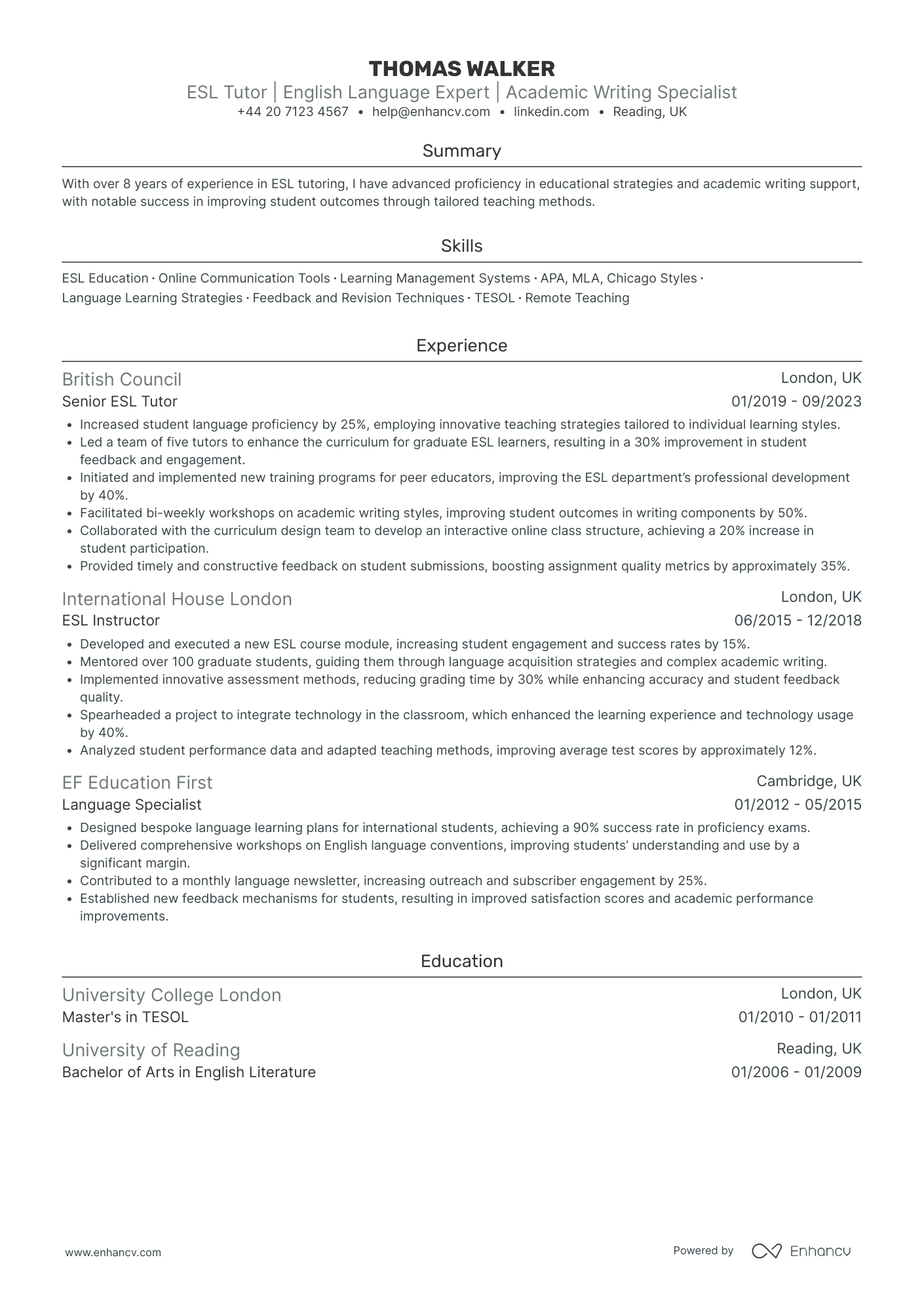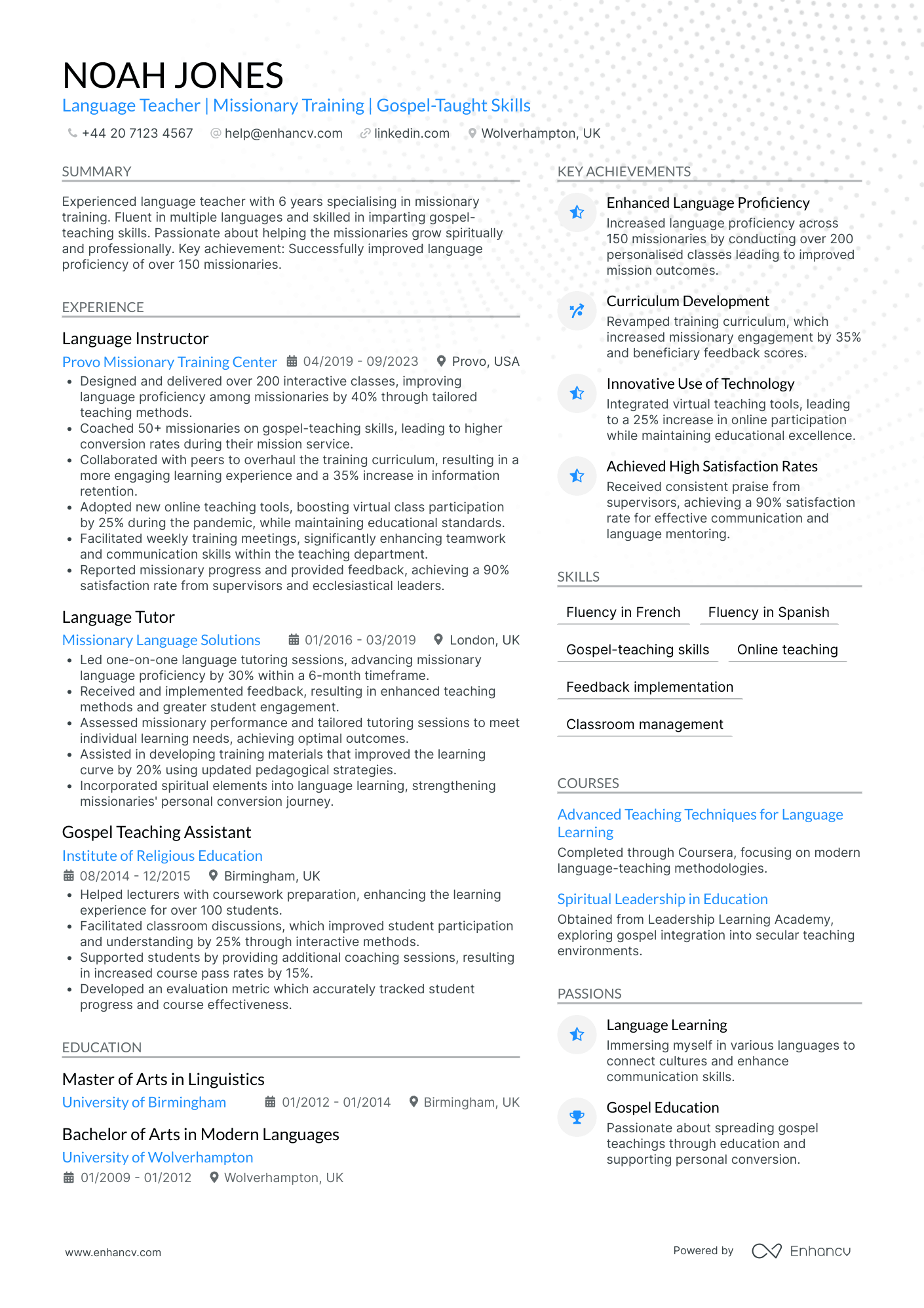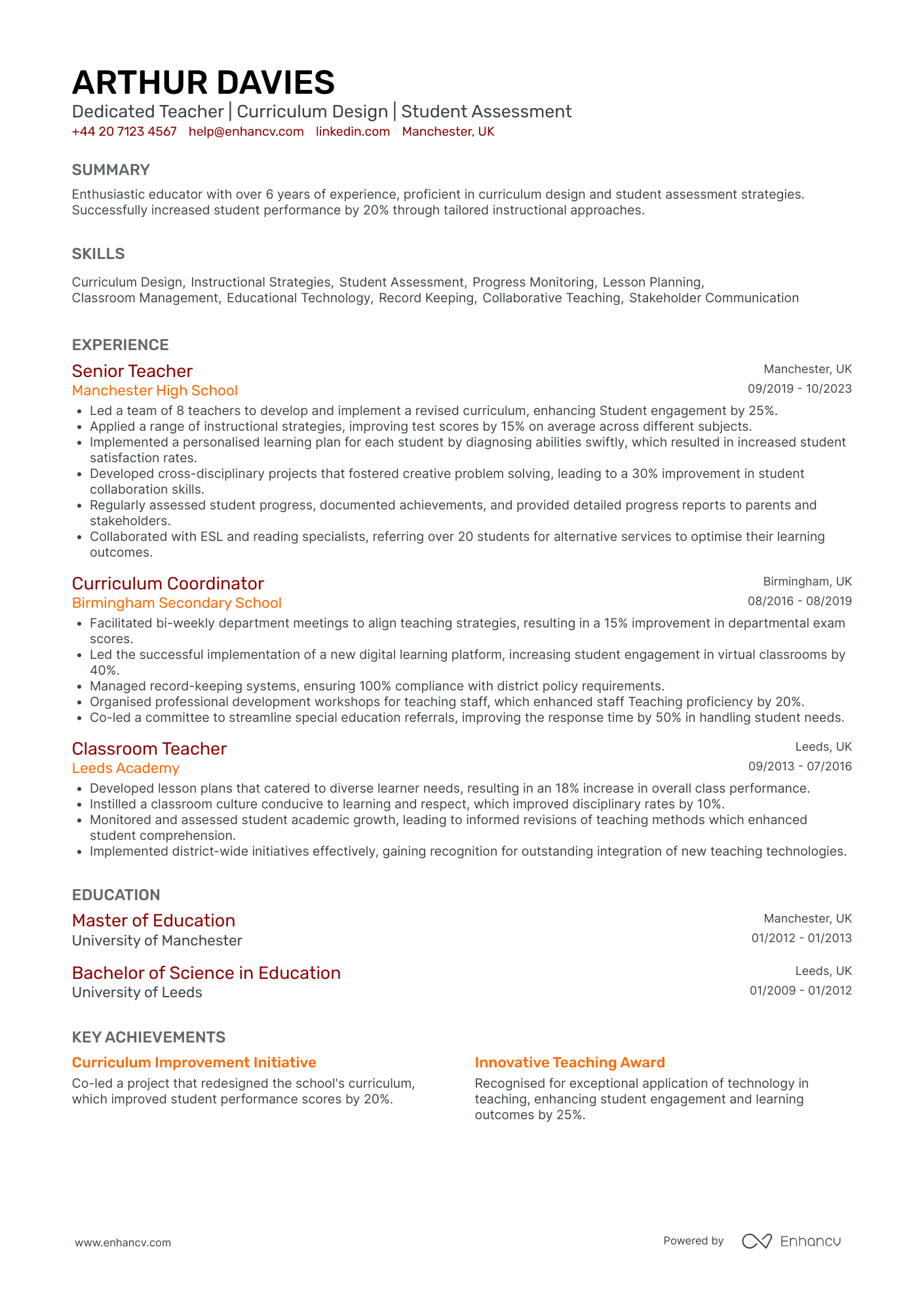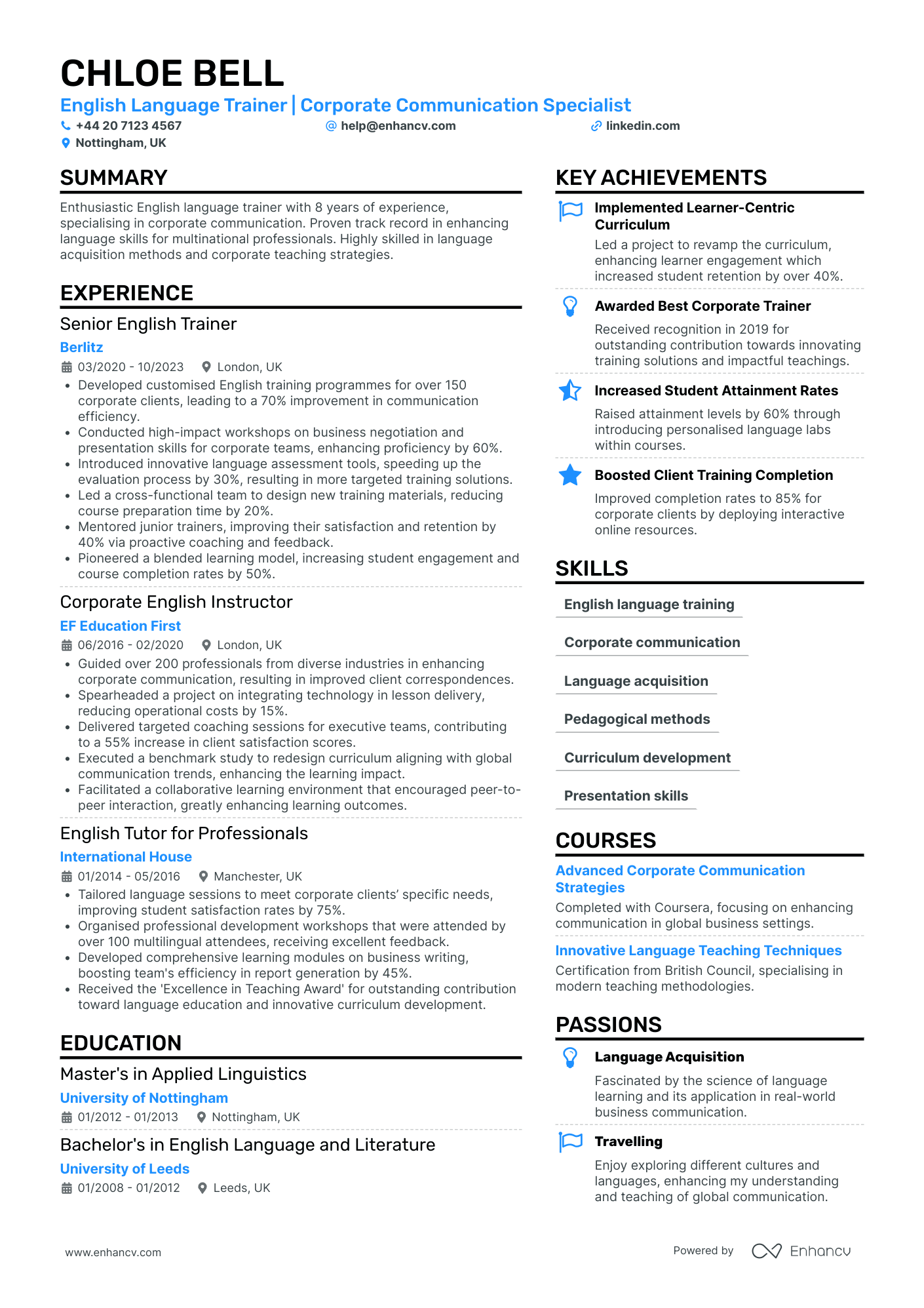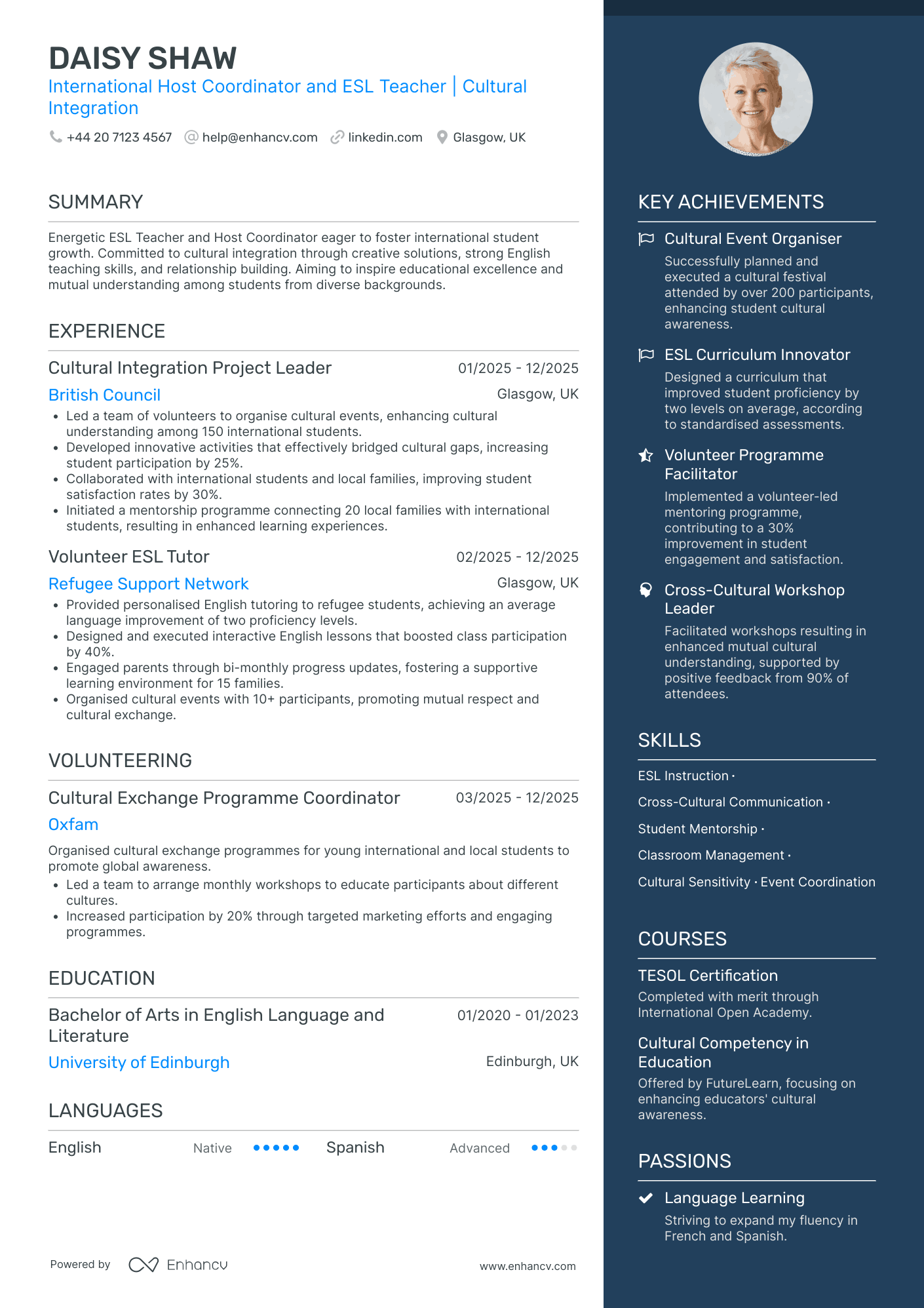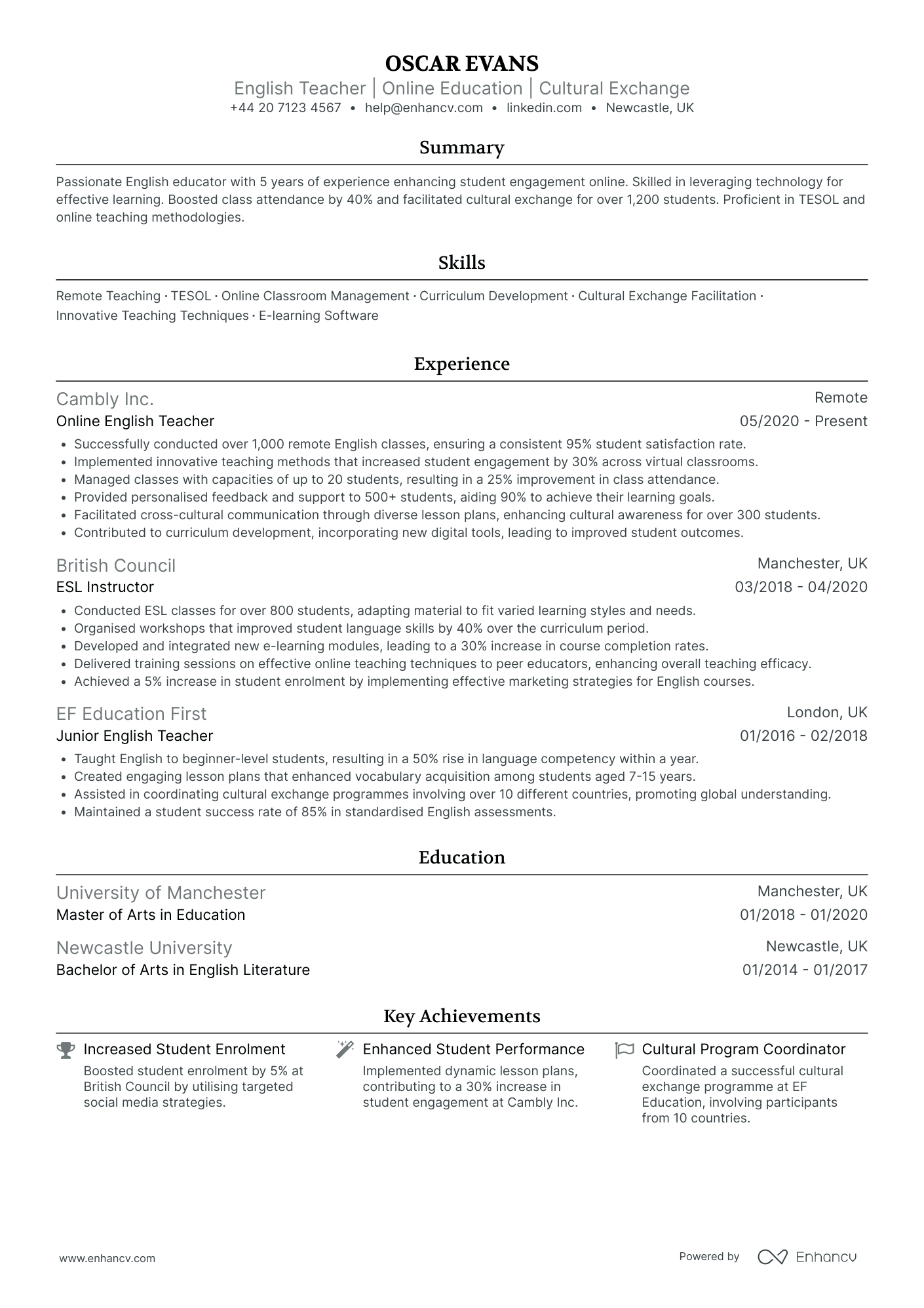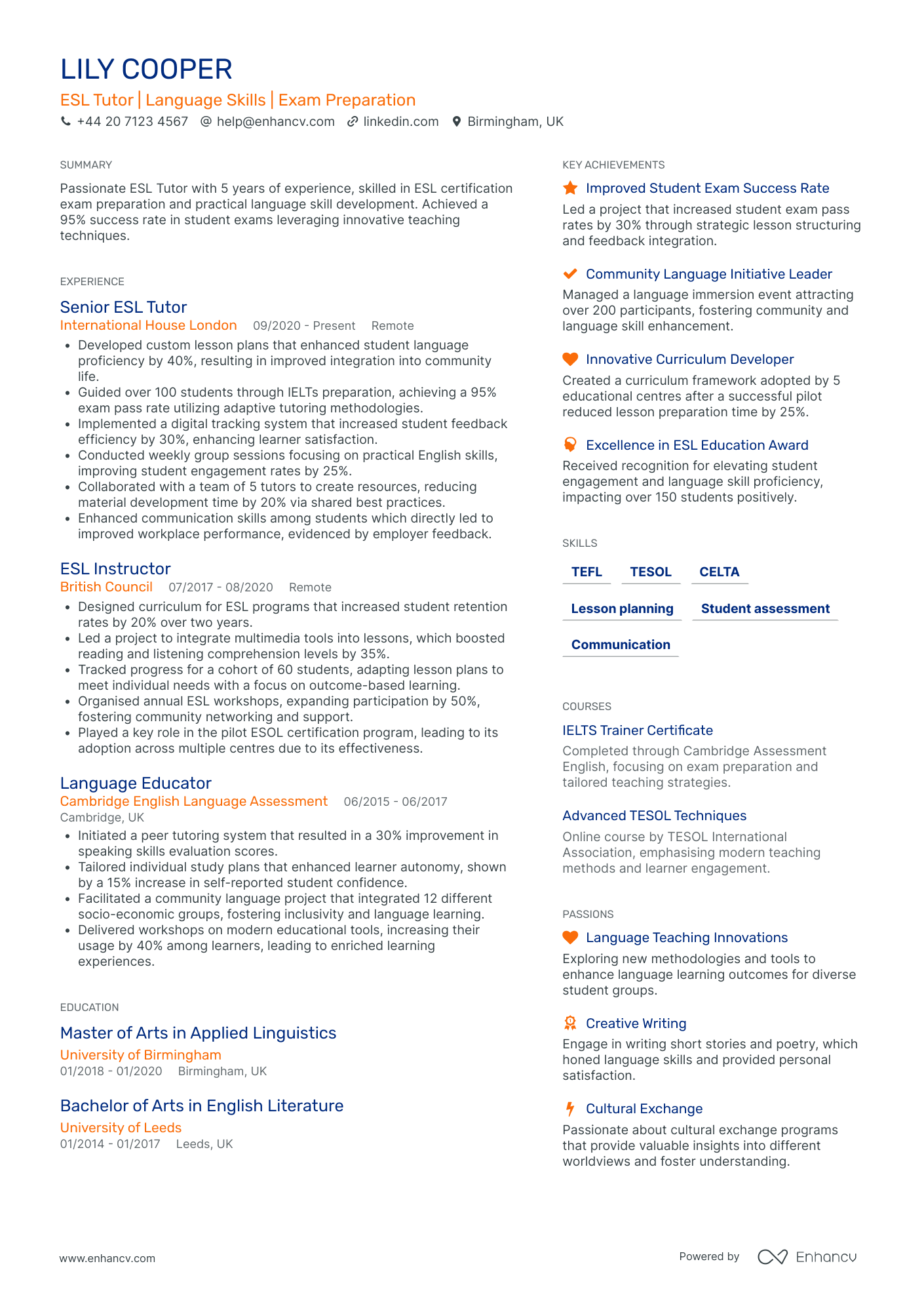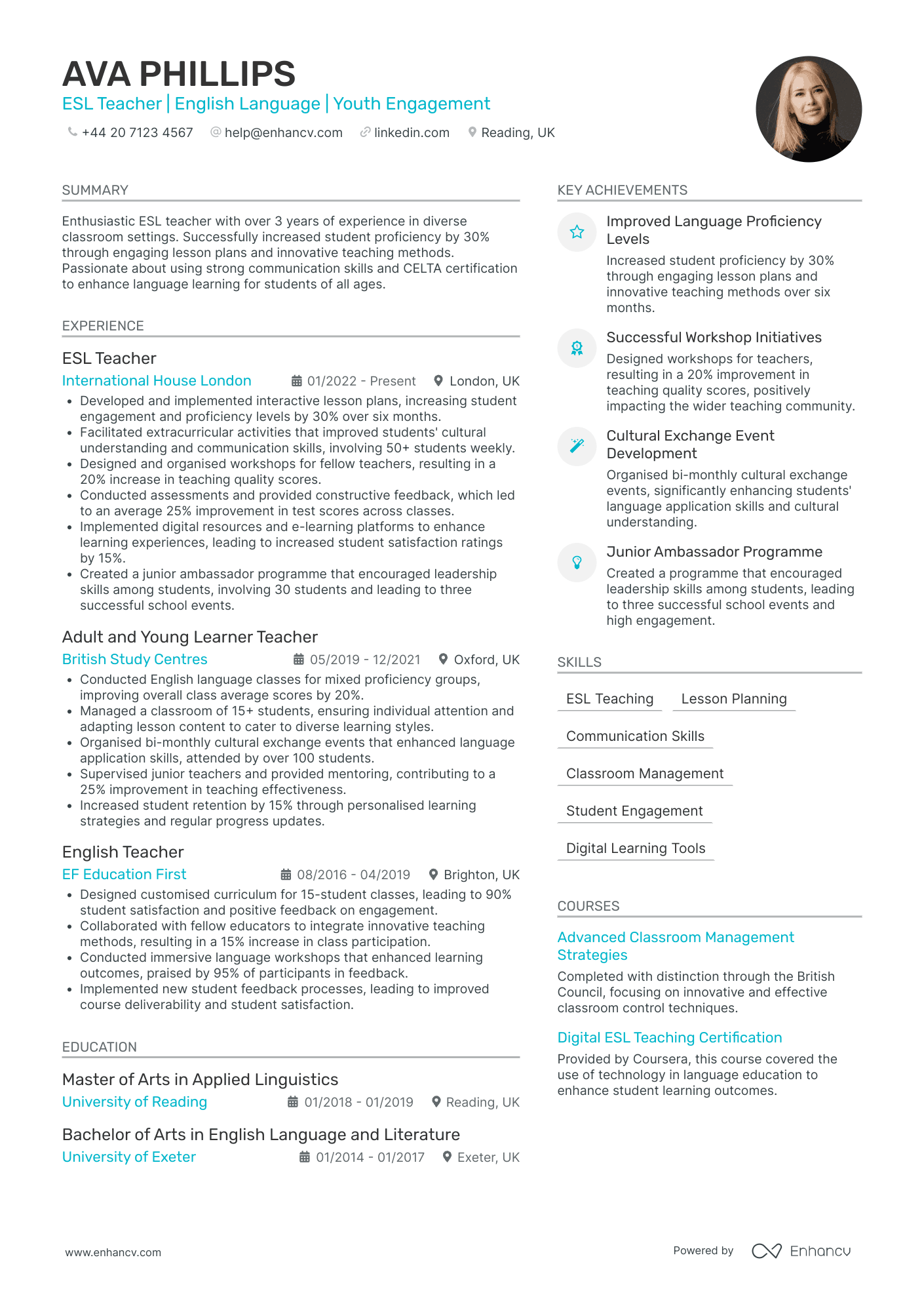One particular CV challenge you might encounter as an ESL teacher is effectively showcasing your diverse teaching experiences and language skills. Our guide provides tailored tips and examples that will help you articulate your unique qualifications and stand out in the competitive job market.
- Design and format your professional esl teacher CV;
- Curate your key contact information, skills, and achievements throughout your CV sections;
- Ensure your profile stays competitive by studying other industry-leading esl teacher CVs;
- Create a great CV even if you happen to have less professional experience, or switching fields.
When writing your esl teacher CV, you may need plenty of insights from hiring managers. We have prepared industry-leading advice in the form of our relevant CV guides.
CV examples for esl teacher
By Experience
Entry-level ESL Teacher
- Structured career progression - Theodore Green's CV showcases a comprehensive and logical career trajectory, moving from a Language and Literacy Specialist to an ESL Teacher. This progression illustrates steady growth within the field of language education, emphasizing continuous skill enhancement and adaptation to more responsible roles.
- Integration of educational technology - The CV highlights Theodore's proficiency in implementing software solutions for student tracking, which reduced record-keeping errors by 40%. This detail underlines an adeptness with educational technology, an invaluable skill in modern teaching environments, optimizing efficiency and educational outcomes.
- Impactful community and program development - Achievements are presented with a clear link to student and community impact, such as the 25% increase in student enrolment through strategic collaboration with local organizations. This indicates a strong ability to expand and improve educational programs, adding significant value to the institutions involved.
Mid-level ESL Teacher
- Strategic Career Development - Scarlett Murphy's career trajectory is marked by deliberate growth within the educational sector. Transitioning from an Educational Support Officer to a specialized role in ESL and Special Education demonstrates a focused commitment to expanding her expertise. Her roles have progressively embraced higher responsibilities, showcasing her proactive approach to career advancement and dedication to educational excellence.
- Integration of Data-Driven Methodologies - A standout feature of this CV is Murphy's adept use of data-driven strategies to improve educational outcomes. Her ability to incorporate analytics to enhance student language proficiency by 20% and close achievement gaps by 15% underlines a sophisticated understanding of data application in educational settings. This technical depth is a valuable asset in today's increasingly metrics-oriented teaching environments.
- Highlights of Leadership and Soft Skills - The CV shines a light on her leadership capabilities through documented achievements such as leading professional development sessions that increased colleague effectiveness by 40%. Furthermore, Murphy's exceptional crisis management skills and commitment to enhancing school-home communication underscore her proficiency in critical soft skills necessary for fostering a productive educational atmosphere.
Senior ESL Teacher
- Structured Career Progression - Theodore Green's CV showcases a clear upward trajectory in his career, moving from an ESL Coordinator to a Senior ESL Teacher at a prestigious institution like the British Council. This progression highlights his growth in responsibility and influence within the field of ESL education, suggesting a professional who is consistently seeking to expand and refine his expertise.
- Innovative Approach to Education - The CV emphasizes Theodore's proficiency in adopting innovative teaching methods and integrating technology into the classroom. His documented success in using digital tools to enhance remote learning, alongside the creation of a language club, demonstrates a forward-thinking educator dedicated to modernization and interactivity in educational environments.
- Comprehensive Skill Set and Versatility - In addition to his specialized ESL instruction skills, Theodore's CV details his abilities in curriculum development, student assessment, and cross-cultural communication. These varied skills are complemented by his proficiency in digital learning tools, demonstrating his adaptability and effectiveness in diverse educational settings.
ESL Department Head
- Clear and Structured Content Presentation - The CV is well-organized, with each section distinctly separated and logically ordered. This ensures clarity, making it easy for readers to navigate through the candidate's career history and educational background. The use of bullet points for achievements and responsibilities aids in conciseness, allowing key information to be quickly extracted.
- Impressive Career Trajectory and Growth - Louis Wood showcases a progressive career trajectory through notable positions at major firms such as PwC, KPMG, and Deloitte. His advancement from a Marketing Analyst to a Senior Marketing Consultant highlights both professional growth and increased responsibility, indicating strong performance and industry recognition.
- Industry-Specific Expertise and Tools Utilization - Louis demonstrates an extensive understanding of digital marketing tools and methodologies, such as SEO optimization, Google Analytics, and email marketing. His mastery in developing high-impact digital strategies and working with data-driven insights solidifies his expertise in crafting strategies that align with current industry best practices.
ESL Teacher Trainer
- Clear and Concise Presentation - The CV is organized methodically, presenting information in a logical structure, which enhances readability. The use of clear section headings ensures that the reader can easily navigate through the candidate's experiences, skills, and achievements. Each role lists specific duties concisely, preventing any ambiguity about the candidate’s responsibilities and accomplishments.
- Progressive Career Growth - Louis Wood’s career trajectory illustrates a clear path of growth within the ESL field. Starting as a Junior ESL Tutor, he progressively moved to roles with more responsibility, culminating in a Senior ESL Instructor position. His advancement reflects a strong track record of professional development and recognition within educational organizations.
- Innovative Use of Digital Tools - The CV highlights Louis's proficiency with digital tools in education, a crucial aspect for modern teaching methodologies. Implementing these tools not only increased student interaction by 30% but also enhanced satisfaction ratings and course completion rates. This reflects his ability to leverage technology effectively to optimize learning experiences.
By Role
ESL Kindergarten Teacher
- Structured Presentation Enhances Understanding - The CV is organized with precise headings and subheadings, facilitating easy navigation through different sections. The clarity of roles and responsibilities within each job segment underlines the candidate's proficiency in communicating complex ideas succinctly, crucial for an educational role.
- Rich Experience in ESL and Remote Teaching - Grace’s career trajectory displays consistent growth in the ESL domain, transitioning from primary school teaching to specialized online ESL instruction. Her adaptability to remote roles underscores a keen ability to evolve with industry trends and technological advancements, vital for an online educator.
- Embracing Technology for Enhanced Learning - Incorporating advanced online teaching strategies, the CV highlights the candidate's adeptness with Zoom and other digital tools to facilitate educational sessions. This technical fluency played a significant role in raising student engagement and satisfaction, aligning well with modern ESL teaching requirements.
ESL Business English Teacher
- Content Presentation and Structure - This CV impressively organizes information with clear section headers, making it easy for readers to navigate through the details. Key achievements and responsibilities are outlined using bullet points, ensuring the candidate’s accomplishments stand out without overwhelming the reader. The balance between clarity, structure, and conciseness helps maintain focus on the candidate’s qualifications for a teaching role.
- Achievements and Business Impact - George Johnson’s career achievements are not just numbers; they show meaningful impact. For example, increasing student engagement by 20% and achieving a 98% student satisfaction rate highlight a significant endorsement of their teaching effectiveness. Such results demonstrate their ability to foster learning environments that are not only engaging but also retain students, which is invaluable for educational institutions looking to enhance their programs.
- Adaptability and Cross-Cultural Experience - The candidate’s experience spans multiple educational institutions and roles, underscoring their ability to adapt to varied teaching environments. Their accomplishments, such as leading intercultural communication workshops, speak not only to adaptability in teaching methods but also to their dedication to promoting cultural understanding and appreciation amongst students—a crucial aspect for roles that involve international and diverse student populations.
ESL Online Tutor
- Concise and structured sections - The CV is well-organized with clearly defined sections for experience, education, skills, languages, and achievements. This clear presentation ensures that key information is easily accessible to the reader and highlights the candidate’s specific qualifications for the role.
- Progressive career trajectory - Isabelle Reed has demonstrated significant growth in her career, transitioning from an ESL Teacher in a physical classroom to an Online ESL & German Tutor with remote teaching responsibilities. This trajectory indicates a strong adaptability to industry shifts towards remote learning environments.
- Innovative use of teaching methods and tools - The candidate showcases proficiency in using e-learning software like Zoom and Google Classroom, paired with the development of interactive teaching tools. These elements demonstrate a strong command of contemporary methodologies that enhance student engagement and learning outcomes.
ESL Secondary School Teacher
- Structured Experience Demonstration - The CV employs a well-organized structure that clearly delineates Chloe Bell's professional journey. Each role is thoroughly detailed with specific timelines, allowing for an easy-to-follow career progression. Key responsibilities and achievements are listed concisely, enhancing clarity and readability while underscoring her professional growth.
- Diverse Skill Set Showcasing Adaptability - Chloe Bell's CV highlights a broad range of skills, such as curriculum development, classroom management, and educational technology, illustrating her versatility and adaptability in various teaching environments. Her mastery of both hard and soft skills indicates a well-rounded competence that is essential in today's dynamic educational landscape.
- Proven Impact on Educational Outcomes - The CV effectively communicates Chloe Bell's impact on student engagement and performance. For instance, her ability to implement curriculum redesigns resulted in significant improvements in both student engagement and academic performance. These accomplishments, supported by concrete statistics, bolster her credibility and demonstrate her capability to produce meaningful outcomes within educational institutions.
ESL Curriculum Developer
- Organized and Cohesive Presentation - The CV is structured in a clear and logical order, with neatly categorized sections. This format enhances readability and ensures that each section seamlessly transitions into the next, allowing the reader to easily navigate through the candidate’s career journey and achievements.
- Progressive Career Advancements - Emily Cox's career trajectory showcases a natural progression in roles within the education sector, evolving from an Assistant Language Teacher to a Senior Curriculum Developer within a span of eight years. This upward movement indicates her growing expertise and readiness to handle more significant responsibilities and leadership roles.
- Integration of EdTech Solutions - A notable highlight is Emily's adeptness at incorporating educational technology into her curriculum development process. Her experiences with initiatives like adopting the latest edtech solutions and developing open-source grammar tools provide a technical depth that supports modern educational needs and enhances learner engagement.
ESL Teacher for Adults
- Effective Content Presentation - Chloe Bell's CV is structured with precision, providing clear headings and bullet points that make the information easily accessible. The concise language and chronological order enhance readability and allow potential employers to quickly identify key qualifications and achievements.
- Impressive Career Trajectory - Throughout Chloe Bell's career, there is a clear upward progression, highlighted by roles at prestigious institutions such as the British Council. Each position demonstrates increased responsibility and scope, reflecting her professional growth and advancement within the field of English language teaching.
- Innovative Teaching Techniques - Chloe excels in utilizing cutting-edge methodologies specific to ESL and EFL education. Her implementation of digital learning resources and e-learning platforms demonstrates a commitment to integrating technology into education, significantly enhancing student engagement and learning outcomes.
ESL Summer Camp Teacher
- Effective Career Progression - Sienna West's CV showcases a strong upward trajectory in the EFL teaching field, highlighting her development from an English Language Tutor to a Senior EFL Teacher at British Council. This progression reflects her growing expertise and leadership in language instruction.
- Robust Use of Educational Tools - The CV emphasizes Sienna's proficiency with digital learning tools and multimedia resources, which she integrated into lessons to enhance student engagement and learning outcomes. These industry-specific elements are critical in today’s teaching landscape, showcasing her ability to adapt teaching methods to modern advancements.
- Balanced Skillset and Leadership Qualities - Sienna demonstrates a blend of hard and soft skills, such as curriculum development and digital literacy, alongside student mentoring and cultural awareness. Her leadership is further exemplified by her role in mentoring new teachers and driving innovative teaching strategies for enhanced student participation.
ESL Teacher for Immigrants
- Clear and Structured Presentation - The CV is well-organized, starting with personal details and a concise summary that outlines Thomas Walker's qualifications as an ESL Tutor and language expert. The sectioning is logical, with a clear flow from education to professional experience, which makes it easy for employers to navigate his background. His skills, experiences, and achievements are concisely presented, ensuring clarity and conciseness.
- Progressive Career Growth in ESL Education - Thomas Walker’s career trajectory shows a clear progression from Language Specialist to Senior ESL Tutor. This upward movement within reputable organizations like the British Council and International House London demonstrates his growing responsibilities and expertise in ESL education and academic writing. His responsibilities have evolved from developing individual learning plans to leading curriculum enhancements and tutor teams.
- Incorporation of Innovative Teaching Tools - The CV highlights Thomas's adeptness with industry-specific tools and methodologies, such as using Online Communication Tools and Learning Management Systems to enhance ESL education. His involvement in integrating technology in the classroom and designing innovative online class structures underscores his technical depth and adaptability to modern educational environments.
ESL Teacher for Refugees
- Strong Content Presentation - The CV is well-structured and clearly presented, with distinct sections for experience, education, skills, and achievements. This organization ensures that a potential employer can quickly identify key information, showcasing Noah's qualifications in an easily accessible manner.
- Consistent Career Progression - Noah's career trajectory demonstrates significant growth, transitioning from a Gospel Teaching Assistant to a Language Instructor at a renowned missionary training center. This progression highlights not only an increase in responsibilities but also solid experience in the education sector, emphasizing dedication and skill development.
- Innovative Use of Technology in Education - The CV makes a noteworthy point about the integration of online teaching tools, which was particularly crucial during the pandemic. This adaptability to technological advancements highlights Noah's capability to maintain educational standards and increase participation, demonstrating a forward-thinking approach to teaching.
ESL Special Education Teacher
- Streamlined Content Presentation - The CV exhibits a well-organized structure, starting with a concise summary, followed by clearly delineated sections detailing the candidate's education, work experience, achievements, skills, and additional qualifications. This clarity ensures easy readability and allows potential employers to quickly identify the candidate's strengths and accomplishments.
- Strategic Career Growth - Arthur Davies’ career trajectory demonstrates a consistent growth path, with promotions from a Classroom Teacher to a Curriculum Coordinator and finally a Senior Teacher. Each role highlights a progression in responsibility and impact, showcasing the candidate’s ability to take on increased leadership roles and effect positive change in educational environments.
- Effective Application of Soft Skills and Leadership - The CV underscores strong soft skills and leadership abilities, demonstrated through Arthur’s experience in leading teams, organizing workshops, and collaborating with specialists. This capacity to guide and support colleagues and students alike is crucial in the educational sector, where leadership and empathy play key roles in driving success and improvement.
ESL Corporate Trainer
- Compelling Career Progression - Chloe Bell's CV illustrates a clear upward trajectory, starting as an English Tutor for Professionals and progressing to a Senior English Trainer role at Berlitz. The steady advancement over the years reflects her growth in expertise and responsibility within the field of corporate communication training.
- Strategic Application of Industry-Specific Tools - The CV highlights Chloe's adept use of innovative language assessment tools and blended learning models, which have notably streamlined training processes and increased engagement. Her ability to integrate technology into teaching practices underscores her commitment to evolving with industry trends.
- Strong Emphasis on Mentorship and Leadership - Chloe's experience is rich with examples of her leadership qualities, particularly through initiatives like mentoring junior trainers and facilitating workshops. Her approach to proactive coaching signals her dedication to fostering a positive learning and growth environment for both trainees and colleagues.
ESL Teacher for International Students
- Strong Focus on Cultural Integration - The summary and experience sections highlight a deep commitment to cultural integration and fostering mutual understanding. The candidate leverages creative solutions to bridge cultural gaps, which is critical in the role of International Host Coordinator.
- Leadership and Initiative - Daisy's experience as a Cultural Integration Project Leader and Volunteer Programme Facilitator demonstrates her leadership skills and ability to initiate impactful programs. Her efforts in mentorship and volunteer programs consistently led to improved satisfaction and participation, showcasing her capability to lead successful initiatives.
- Effective Communication and Relationship Building - The CV emphasizes strong communication skills through roles involving ESL instruction and student mentorship. Daisy's ability to engage with students, local families, and international participants is evident, highlighting her effectiveness in building relationships and fostering a supportive educational environment.
ESL Examination Preparation Teacher
- Clear and Structured Content Presentation - Oscar Evans’ CV is neatly structured with clearly defined sections, each addressing pertinent aspects of his professional journey. The layout ensures clarity, making it easy to navigate through his qualifications, experience, skills, and achievements. This organization highlights his accomplishments succinctly, ensuring that key information is instantly accessible to recruiters.
- Significant Career Growth in Online Education - The CV vividly illustrates Oscar's career progression, from a Junior English Teacher to an Online English Teacher. Each role showcases an increasing level of responsibility, underscoring his development from managing beginner-level classes to facilitating cross-cultural communication for large groups. This growth trajectory reflects his dedication and adaptability in the rapidly evolving field of online education.
- Innovative Use of Technology and Teaching Methodologies - Oscar Evans demonstrates a strong command of industry-specific tools and methodologies. His ability to integrate e-learning software and develop online modules highlights his proficiency in applying technological advancements to enhance the teaching experience. Furthermore, his commitment to innovative teaching and curriculum development methodologies sets him apart as a forward-thinking educator in the digital age.
ESL Private Tutor
- Effective Content Presentation - The CV stands out due to its clear and organized structure that enables the reader to easily comprehend the candidate's qualifications. Each section is well-labelled, and bullet points are used to concisely convey key responsibilities and achievements, ensuring a quick and comprehensive overview of their skills and experience.
- Demonstrated Career Growth - There is a clear upward trajectory in Lily's career, transitioning from a Language Educator to Senior ESL Tutor. Each role shows a progression in responsibilities, illustrating her ability to take on more challenges and succeed, ultimately emphasizing her growth within the ESL sphere, both in teaching effectiveness and leadership.
- Innovative Use of Digital Tools - Lily's integration of multimedia tools and digital tracking systems showcases her innovative approach within the ESL industry. These methodologies not only increased student engagement but also improved learning outcomes, highlighting her adaptability and commitment to enhancing educational experiences through technological means.
ESL Teacher in Language School
- Effective Content Organization - The CV is well-structured with clearly defined sections, making it easy to navigate through Ava Phillips' professional journey. Each section provides concise and relevant information, maintaining clarity and focus throughout. This presentation enhances readability and ensures that each achievement and skill is showcased effectively.
- Diverse Experience and Growth - Ava's career trajectory reflects significant growth and adaptation, with experience in various settings such as International House London and British Study Centres. This demonstrates her ability to handle diverse language education environments and progressively assume more responsibilities, showcasing her dedication to career development in the ESL teaching field.
- Rich Array of Industry-Specific Skills - The CV emphasizes unique skills pertinent to the ESL teaching profession, such as designing interactive lesson plans and implementing digital learning tools. These skills, coupled with her CELTA certification, highlight Ava's capacity to incorporate innovative methods that enhance student engagement and proficiency, making her a valuable asset to educational institutions.
Structuring your esl teacher CV layout: four factors to keep in mind
There are plenty of best practices out there for your CV layout and design. At the end of the day, a clear format and concise CV message should be your top priority. Use your CV design to enhance separate sections, bringing them to the forefront of recruiters' attention. At the same time, you can write content that:
- Follows the reverse chronological order in the experience section by first listing your most recent jobs;
- Incorporates your contact information in the header, but do skip out on the CV photo for roles in the UK;
- Is spotlighted in the most important sections of your CV, e.g. the summary or objective, experience, education, etc. to show just how you meet the job requirements;
- Is no longer than two-pages. Often, the one-page format can be optimal for your esl teacher CV.
Before submitting your CV, you may wonder whether to export it in Doc or PDF. With the PDF format, your information and layout stay intact. This is quite useful when your CV is assessed by the Applicant Tracker System (or the ATS) . The ATS is a software that scans your profile for all relevant information and can easily understand latest study on the ATS , which looks at your CV columns, design, and so much more.

PRO TIP
Use font size and style strategically to create a visual hierarchy, drawing the reader's eye to the most important information first (like your name and most recent job title).

The top sections on a esl teacher CV
- Teaching Experience highlights your relevant classroom skills.
- Educational Background shows your qualification for teaching.
- Language Proficiency demonstrates your ability to teach ESL.
- TEFL/TESOL Certification confirms specialised teaching training.
- Cultural Sensitivity reflects your ability to handle diverse classrooms.
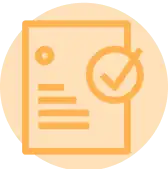
What recruiters value on your CV:
- Highlight your language skills by listing any certifications you have, such as TEFL, TESOL, or CELTA, and emphasise your proficiency, especially in English, but also in other languages you speak.
- Feature any international experience you've had, whether it be studying, working, or volunteering abroad, as it demonstrates cross-cultural communication skills and adaptability.
- Detail your teaching experience by focusing on curriculum development, lesson planning and classroom management, ensuring you showcase your understanding of different learning styles and student needs.
- Showcase your technical abilities, specifically regarding online teaching platforms and digital literacy, to reflect the increasing demand for online ESL education in response to global trends.
- Include examples of how you've contributed to a positive learning environment, such as developing interactive and engaging activities that foster a collaborative classroom atmosphere.
Recommended reads:
Tips and tricks on writing a job-winning esl teacher CV header
The CV header is the space which most recruiters would be referring most often to, in the beginning and end of your application. That is as the CV header includes your contact details, but also a headline and a professional photo. When writing your CV header:
- Double-check your contact details for spelling errors or if you've missed any digits. Also, ensure you've provided your personal details, and not your current work email or telephone number;
- Include your location in the form of the city and country you live in. If you want to be more detailed, you can list your full address to show proximity to your potential work place;
- Don't include your CV photo, if you're applying for roles in the UK or US, as this may bias initial recruiters' assessments;
- Write a professional headline that either integrates the job title, some relevant industry keywords, or your most noteworthy achievement.
In the next part of our guide, we'll provide you with professional CVs that showcase some of the best practices when it comes to writing your headline.

Examples of good CV headlines for esl teacher:
- Experienced ESL Instructor | TEFL Certified | Curriculum Development | Bilingual Education | 7 Years of Teaching Expertise
- Senior ESL Teacher | MA in Applied Linguistics | EAP Specialist | Exam Preparation Pro | 12+ Years Experience
- ESL Education Professional | Young Learners Expert | Creative Lesson Planning | CELTA Holder | 5 Years in Field
- Lead ESL Teacher | IELTS/TOEFL Prep Specialist | Pedagogy Innovator | DELTA Qualified | 10 Years Teaching
- ESL Classroom Facilitator | Interactive Learning Advocate | TEFL Certified | Technology in Ed Enthusiast | 3+ Years Experience
- Advanced ESL Mentor | Teacher Training & Development | Material Design | CELTA | 8-Year Teaching Veteran
Opting between a esl teacher CV summary or objective
Within the top one third of your esl teacher CV, you have the opportunity to briefly summarise your best achievements or present your professional goals and dreams. Those two functions are met by either the CV summary or the objective.
- The summary is three-to-five sentences long and should narrate your best successes, while answering key requirements for the role. Select up to three skills which you can feature in your summary. Always aim to present what the actual outcomes were of using your particular skill set. The summary is an excellent choice for more experienced professionals.
- The objective is more focused on showcasing your unique value as a candidate and defining your dreams and ambitions. Think about highlighting how this current opportunity would answer your career vision. Also, about how you could help your potential employers grow. The objective matches the needs of less experienced candidates, who need to prove their skill set and, in particular, their soft skills.
Still not sure about how to write your CV opening statement? Use some best industry examples as inspiration:

CV summaries for a esl teacher job:
- With over 7 years of dedicated experience in English language teaching and a Master’s in TESOL, I have contributed to the academic success of over 2,000 students across three continents. My proficiency in creating engaging lesson plans and my ability to leverage multimedia tools have resulted in a 95% student pass rate.
- Seasoned educator with 10 years’ experience in secondary schools, specialising in modern language acquisition, seeking to transition into ESL teaching. Expert in curriculum development and assessment, with a proven track record of fostering student-centred learning environments that accommodate learners of diverse backgrounds.
- A seasoned professional in international business with extensive cross-cultural communication skills, eager to transfer 8 years of expertise into the ESL teaching domain. Bringing a deep understanding of practical language application in business contexts and a commitment to developing comprehensive ESL programmes for professional development.
- Passionate about languages and with a BA in English Literature, I am transitioning into ESL education to facilitate effective language learning. With substantial experience volunteering in multicultural environments and possessing native-level English proficiency, my aim is to create a dynamic and inclusive learning atmosphere for students of all ages.
- As a recent CELTA graduate, I am excited to embark on my ESL teaching career. Eager to apply my knowledge of contemporary teaching methodologies and my strong linguistic background, my objective is to deliver memorable and impactful English learning experiences that contribute to my students’ lifelong success in a global community.
- Aspiring to utilise my recent TEFL certification and passion for language education in an ESL teaching capacity, my goal is to foster an engaging and supportive environment that encourages students to improve their English skills and achieve their educational objectives, while continuously developing my own teaching practice.
More detailed look into your work history: best advice on writing your esl teacher CV experience section
The CV experience is a space not just to merely list your past roles and responsibilities. It is the CV real estate within which you could detail your greatest accomplishments and skills, while matching the job requirements. Here's what to have in your experience section:
- Prove you have what the job wants with your unique skill set and past successes;
- Start each bullet with a strong, action verb, and continue with the outcome of your responsibility;
- Use any awards, nominations, and recognitions you've received as solid proof of your skill set and expertise;
- align your experience with the role responsibilities and duties.
For more help on how to write your CV experience section, check out the next section of our guide:

Best practices for your CV's work experience section
- Designed and implemented engaging lesson plans tailored to the diverse learning needs of students, effectively incorporating visual, auditory, and kinesthetic techniques to enhance comprehension.
- Employed varied assessment methodologies to monitor student progress and provided constructive feedback, resulting in a visible improvement in language skills over each term.
- Maintained a stimulating classroom environment conducive to learning by utilising innovative teaching aids and interactive digital platforms, fostering active participation and student engagement.
- Collaborated with fellow educators and administrative staff to develop school-wide language curricula, demonstrating a commitment to harmonising departmental teaching objectives and standards.
- Regularly attended professional development workshops and integrated the latest ESL teaching methodologies, demonstrating a dedication to ongoing personal and professional growth.
- Provided individualised support and tutoring sessions for students requiring additional assistance, leading to marked improvements in their language proficiency and self-confidence.
- Effectively managed classroom behaviour using positive reinforcement strategies, ensuring a respectful and supportive learning environment that accommodated students from various cultural backgrounds.
- Facilitated language acquisition through the incorporation of cultural immersion activities and real-life contexts, thereby increasing students' understanding of English in a broader cultural framework.
- Actively communicated with parents and guardians about student progress and ways to support learning at home, recognising the importance of a collaborative approach to education.
- Developed a comprehensive ESL curriculum catered to adult learners, resulting in a 45% increase in student language proficiency levels within the first year.
- Implemented an innovative peer-teaching program which allowed advanced students to mentor beginners, enhancing the learning experience for both and improving the program’s overall efficiency.
- Organised and led an annual English Language Festival, attracting over 200 participants and fostering cultural exchange amongst the student body.
- Collaborated with colleagues to integrate technology in the classroom through the use of language learning applications and platforms, leading to a more engaged student base.
- Directed a summer ESL immersion program that increased the enrolment by 30% two consecutive years due to its innovative and interactive teaching methods.
- Pioneered a cross-cultural communication workshop which supported learners in understanding diverse cultural contexts and expanded students' global awareness.
- Introduced a task-based learning approach to the curriculum, boosting students' real-life language application skills and leading to a 20% improvement in conversational English assessments.
- Managed the 'English for Business' course, curating content relevant to international trade, which supported 15 professionals in achieving their career advancement goals.
- Spearheaded a student exchange program with an international partner school, which enriched the educational ecosystem and provided broader experiences for fifty students.
- Organised a tri-weekly language workshop that encouraged student engagement, applying a communicative language teaching methodology that led to improved student confidence in speaking.
- Facilitated the Teacher Training Program, mentoring newly qualified teachers, which enhanced instructional quality and consistency across the department.
- Devised and integrated an assessment tracking system, which allowed for more personalised feedback to students, consequently improving the average IELTS scores by 1.5 points.
- Championed a bilingual education initiative, incorporating native language support into the English curriculum, thus reducing student attrition rates by 25%.
- Orchestrated an international cultural event that showcased students’ diversity and engaged over 300 community members.
- Authored an ESL textbook focused on conversational skills which was adopted by four language institutes in the region, enhancing students’ everyday English usage.
- Led a digital literacy project for ESL learners, incorporating digital tools into daily lessons that resulted in a 40% increase in digital user confidence among students.
- Curated a student-centered language learning blog as a supplementary resource, which received an average of 1,000 monthly visits and enhanced out-of-class language engagement.
- Formulated and executed lesson plans that adhered to the Common European Framework of Reference for Languages, ensuring high-quality teaching standards were met.
- Customised ESL tutoring programs for over 100 C-level executives, focusing on industry-specific terminology and scenarios, facilitating international business negotiations and expansions.
- Delivered interactive, online ESL classes to remote students across six countries, which broadened the institute’s global reach and increased its international student body by 50%.
- Analysed student performance data to continually refine teaching methodologies that increased students' TOEFL scores by an average of 15 points overall.
- Led the creation of an immersive language-learning environment, transforming a traditional classroom into a dynamic and interactive space, subsequently raising student retention by 35%.
- Drove a successful fundraising campaign for ESL learning materials, securing a £5,000 grant to purchase authentic language resources for the school library.
- Fostered partnerships with local businesses to provide vocational English classes, equipping 200+ students with the linguistic tools needed for job placement in English-speaking environments.
What to add in your esl teacher CV experience section with no professional experience
If you don't have the standard nine-to-five professional experience, yet are still keen on applying for the job, here's what you can do:
- List any internships, part-time roles, volunteer experience, or basically any work you've done that meets the job requirements and is in the same industry;
- Showcase any project you've done in your free time (even if you completed them with family and friends) that will hint at your experience and skill set;
- Replace the standard, CV experience section with a strengths or achievements one. This will help you spotlight your transferrable skills that apply to the role.
Recommended reads:

PRO TIP
Include examples of how you adapted to new tools, environments, or work cultures, showing your flexibility.
Key esl teacher CV skills: what are hard skills and soft skills
Let's kick off with the basics. You know that you have to include key job requirements or skills across your CV. For starters, take individual skills from the job description and copy-paste them into your CV, when relevant. Doing so, you'll ensure you have the correct skill spelling and also pass the Applicant Tracker System (ATS) assessment. There are two types of skills you'll need to include on your CV:
- Hard skills - technical abilities that are best defined by your certificates, education, and experience. You could also use the dedicated skills section to list between ten and twelve technologies you're apt at using that match the job requirements.
- Soft skills - your personal traits and interpersonal communication skills that are a bit harder to quantify. Use various CV sections, e.g. summary, strengths, experience, to shine a spotlight on your workspace achievements, thanks to using particular soft skills.
Remember that your job-winning CV should balance both your hard and soft skills to prove your technical background, while spotlighting your personality.
Top skills for your esl teacher CV:
TEFL/TESOL Certification
Curriculum Development
Lesson Planning
Classroom Management
Linguistics Knowledge
Assessment Design
Educational Technology
Language Proficiency Assessment
Intercultural Communication
Resource Development
Adaptability
Patience
Creativity
Communication
Empathy
Collaboration
Organisational Skills
Time Management
Motivational Skills
Problem-Solving

PRO TIP
If there's a noticeable gap in your skillset for the role you're applying for, mention any steps you're taking to acquire these skills, such as online courses or self-study.
Education and more professional qualifications to include in your esl teacher CV
If you want to showcase to recruiters that you're further qualified for the role, ensure you've included your relevant university diplomas. Within your education section:
- Describe your degree with your university name(-s) and start-graduation dates;
- List any awards you've received, if you deem they would be impressive or are relevant to the industry;
- Include your projects and publications, if you need to further showcase how you've used your technical know-how;
- Avoid listing your A-level marks, as your potential employers care to learn more about your university background.
Apart from your higher education, ensure that you've curated your relevant certificates or courses by listing the:
- name of the certificate or course;
- name of the institution within which you received your training;
- the date(-s) when you obtained your accreditation.
In the next section, discover some of the most relevant certificates for your esl teacher CV:

PRO TIP
Order your skills based on the relevance to the role you're applying for, ensuring the most pertinent skills catch the employer's attention first.
Recommended reads:
Key takeaways
Your successful job application depends on how you well you have aligned your esl teacher CV to the job description and portrayed your best skills and traits. Make sure to:
- Select your CV format, so that it ensures your experience is easy to read and understand;
- Include your professional contact details and a link to your portfolio, so that recruiters can easily get in touch with you and preview your work;
- Write a CV summary if you happen to have more relevant professional experience. Meanwhile, use the objective to showcase your career dreams and ambitions;
- In your CV experience section bullets, back up your individual skills and responsibilities with tangible achievements;
- Have a healthy balance between hard and soft skills to answer the job requirements and hint at your unique professional value.
